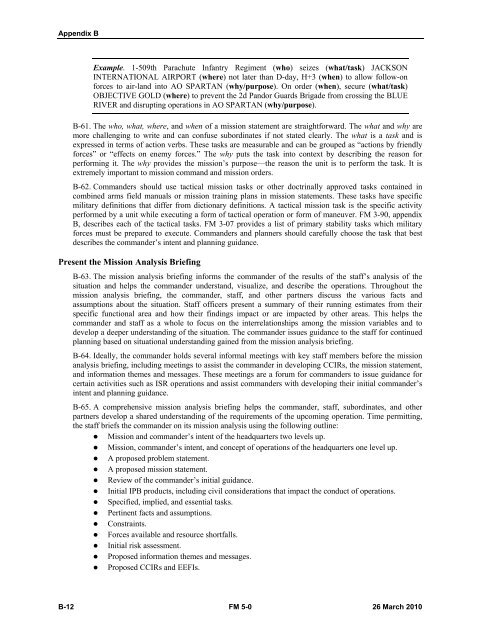FM 5-0, The Operations Process - Federation of American Scientists
FM 5-0, The Operations Process - Federation of American Scientists
FM 5-0, The Operations Process - Federation of American Scientists
Create successful ePaper yourself
Turn your PDF publications into a flip-book with our unique Google optimized e-Paper software.
Appendix B<br />
Example. 1-509th Parachute Infantry Regiment (who) seizes (what/task) JACKSON<br />
INTERNATIONAL AIRPORT (where) not later than D-day, H+3 (when) to allow follow-on<br />
forces to air-land into AO SPARTAN (why/purpose). On order (when), secure (what/task)<br />
OBJECTIVE GOLD (where) to prevent the 2d Pandor Guards Brigade from crossing the BLUE<br />
RIVER and disrupting operations in AO SPARTAN (why/purpose).<br />
B-61. <strong>The</strong> who, what, where, and when <strong>of</strong> a mission statement are straightforward. <strong>The</strong> what and why are<br />
more challenging to write and can confuse subordinates if not stated clearly. <strong>The</strong> what is a task and is<br />
expressed in terms <strong>of</strong> action verbs. <strong>The</strong>se tasks are measurable and can be grouped as “actions by friendly<br />
forces” or “effects on enemy forces.” <strong>The</strong> why puts the task into context by describing the reason for<br />
performing it. <strong>The</strong> why provides the mission’s purpose—the reason the unit is to perform the task. It is<br />
extremely important to mission command and mission orders.<br />
B-62. Commanders should use tactical mission tasks or other doctrinally approved tasks contained in<br />
combined arms field manuals or mission training plans in mission statements. <strong>The</strong>se tasks have specific<br />
military definitions that differ from dictionary definitions. A tactical mission task is the specific activity<br />
performed by a unit while executing a form <strong>of</strong> tactical operation or form <strong>of</strong> maneuver. <strong>FM</strong> 3-90, appendix<br />
B, describes each <strong>of</strong> the tactical tasks. <strong>FM</strong> 3-07 provides a list <strong>of</strong> primary stability tasks which military<br />
forces must be prepared to execute. Commanders and planners should carefully choose the task that best<br />
describes the commander’s intent and planning guidance.<br />
Present the Mission Analysis Briefing<br />
B-63. <strong>The</strong> mission analysis briefing informs the commander <strong>of</strong> the results <strong>of</strong> the staff’s analysis <strong>of</strong> the<br />
situation and helps the commander understand, visualize, and describe the operations. Throughout the<br />
mission analysis briefing, the commander, staff, and other partners discuss the various facts and<br />
assumptions about the situation. Staff <strong>of</strong>ficers present a summary <strong>of</strong> their running estimates from their<br />
specific functional area and how their findings impact or are impacted by other areas. This helps the<br />
commander and staff as a whole to focus on the interrelationships among the mission variables and to<br />
develop a deeper understanding <strong>of</strong> the situation. <strong>The</strong> commander issues guidance to the staff for continued<br />
planning based on situational understanding gained from the mission analysis briefing.<br />
B-64. Ideally, the commander holds several informal meetings with key staff members before the mission<br />
analysis briefing, including meetings to assist the commander in developing CCIRs, the mission statement,<br />
and information themes and messages. <strong>The</strong>se meetings are a forum for commanders to issue guidance for<br />
certain activities such as ISR operations and assist commanders with developing their initial commander’s<br />
intent and planning guidance.<br />
B-65. A comprehensive mission analysis briefing helps the commander, staff, subordinates, and other<br />
partners develop a shared understanding <strong>of</strong> the requirements <strong>of</strong> the upcoming operation. Time permitting,<br />
the staff briefs the commander on its mission analysis using the following outline:<br />
• Mission and commander’s intent <strong>of</strong> the headquarters two levels up.<br />
• Mission, commander’s intent, and concept <strong>of</strong> operations <strong>of</strong> the headquarters one level up.<br />
• A proposed problem statement.<br />
• A proposed mission statement.<br />
• Review <strong>of</strong> the commander’s initial guidance.<br />
• Initial IPB products, including civil considerations that impact the conduct <strong>of</strong> operations.<br />
• Specified, implied, and essential tasks.<br />
• Pertinent facts and assumptions.<br />
• Constraints.<br />
• Forces available and resource shortfalls.<br />
• Initial risk assessment.<br />
• Proposed information themes and messages.<br />
• Proposed CCIRs and EEFIs.<br />
B-12 <strong>FM</strong> 5-0 26 March 2010















